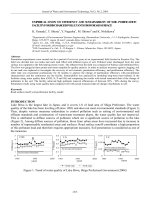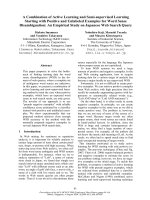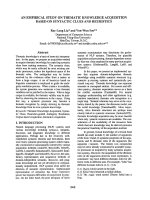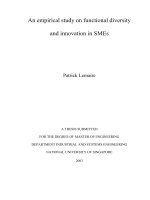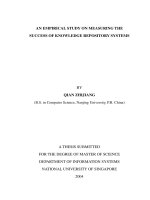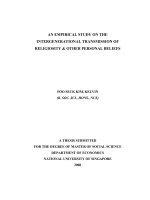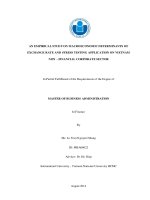Master Thesis in Economics: An empirical study on the impact of recession on training and development in small to medium sized firms in Ireland
Bạn đang xem bản rút gọn của tài liệu. Xem và tải ngay bản đầy đủ của tài liệu tại đây (894.07 KB, 113 trang )
An empirical study on the impact of recession on training and
development in small to medium sized firms in Ireland
MBA(HRM)
Sara Naqi Mirza
1
August 2013
An empirical study on the impact of recession on training and
development in small to medium sized firms in Ireland.
By: Sara Naqi Mirza
Student Id: 1728354
Supervisor: Gay White
Word Count: 21,411
A dissertation submitted in part fulfillment of the requirements of the Masters in Business
Administration (Human Resource Management) to Dublin Business School and
Liverpool
John Moore’s University
August 2013
2
DECLARATION
I, Sara Naqi Mirza, declare that the work contained in this
dissertation is entirely my own and that all sources used
have been acknowledged as per the requirements.
Signed:…………………………….
Date:………………………………
3
TABLE OF CONTENTS
Chapter 1: Introduction……………………………………………….12
1.1 Introduction…………………………………………………….13
1.2 Background of the problem…………………………………….13
1.3 Aim and objectives of the research…………………………….14
1.4 Suitability of the researcher and interest of subject area ………15
1.5 Recipients of the research………………………………………15
1.6 Learning style of the researcher………………………………. .15
1.7 Limitations and contributions of the research………………… .16
1.8 Organization of the dissertation………………………………. .16
Chapter 2: Literature Review…………………………………,……18
2.1 Importance of SMEs in Ireland…………………………….... 19
2.2 Impact of recession on SMEs………………………………... 21
2.3 Training and Development………………………………….. 24
2.4 Training and development in recession………………….… .27
2.5 Effect of Training and Development on motivation ……….. 30
and performance
2.5.1 Social Exchange Theory……………………………………….…32
2.5.2 Training: a source of intrinsic or extrinsic
motivation?.................................................................................34
4
2.6 Importance of "Effective" T&D Initiatives………………….34
Chapter 3: Research Methodology………………………………39
3.1 Research Questions……………………………………40
3.2 Research Methodology………………………………..42
3.3 Research Design ……………………………………..43
3.3.1 Research Philosophy…………………………..44
3.3.1.1 Epistemology -Interpretivism……………..44
3.3.1.2 Ontology - Subjectivism…………………..46
3.3.2 Research Approach :Inductive………………….47
3.3.3 Research Strategy: Case Study………………….48
3.3.4 Research Choice………………..……………….49
3.3.5 Time Horizon…………………………………...50
3.3.6 Data Collection and Analysis……..………..…..50
3.3.6.1 Data Collection……………………….50
3.3.6.2 Data Analysis…………………………52
3.4 Research Ethics……………………………………….53
Chapter 4: Data Analysis and Findings……………………...…55
4.1 Data Analysis………………………………..……….56
4.2 Research Findings……………………………….……58
4.2.1 Research Question no. 1…………………….….58
4.2.2 Research Question no. 2……………………….59
5
4.2.3 Research Question no. 3…………………………61
Chapter 5: Discussion……………………………………………63
5.1 Discussion of the Findings……………………………..64
5.2 Limitations of the study…………………………………68
Chapter 6: Conclusion and Recommendations……………………70
6.1 Conclusion……………………………………………….71
6.2 Further Research…………………………………………73
6.3 Recommendations………………………………………..74
Chapter 7: Reflection and Skill Development………………… …76
7.1 Introduction……………………………………………….77
7.2 Reflection…………………………………………………77
7.2.1 Reflection on the Process…………………………….77
7.2.2 Reflection on the Sources…………………………….79
7.2.3 Reflection on Dissertation formulation…………… .80
7.2.4 Reflection on your own learning…………………….81
7.3 Skill Development………………………………………….83
7.4 Conclusion………………………………………………….85
Bibliography………………………………………………………….86
Appendices……………………………………………………………96
6
Appendix A : Different Learning Styles…………………………..… .97
Appendix B: T&D techniques used within organizations…………... 98
Appendix C: Interview Guides………………………………………..103
Appendix D: Ethical Stances………………………………………….106
Appendix E: Request Email to companies……………………………107
Appendix F: Confidentiality Agreements…………………………….108
Appendix G : Personal SWOT analysis………………………………112
7
LIST OF FIGURES:
Figure 1: Business economy in Ireland : SME % versus Non SME % by
sector.
Figure 2: Identifying gap and need for training
Figure 3: Bramley's model of Training
Figure 4: Developing a research question for a qualitative study
Figure 5: The Research Onion
Figure 6: Kolb's Learning Styles
8
ACKNOWLEDGEMENTS
I have a few special people in my life , to thank.
First of all, Thank you PAPA! for your support, love and
encouragement. Thank you for being strong to send me away.
I love you so much!
My brother , Ali who has always been more confident than my
own self that I CAN DO IT!
My best friend Saba, You are my pillar of strength!
Thank you for being there for me through every thick and thin. We
truly have faced life together!
And…. this Masters is for my mother and sister .
For I know…You are very proud!
A special thanks to my supervisor Ms. Gay White for constantly
supporting me and being so encouraging.
Lastly, all those who took time out to participate in my research.
9
ABSTRACT
Employees are regarded as assets to a firm. Training and developing them so that they
can contribute towards the success of a firm should be paramount.
Though, with the economic upheaval , and with pressures mounting on firms to survive,
it is widely assumed that these techniques and initiatives have taken a back seat, and
rather is the first area to face budget cuts.
The researcher has tried to investigate this school of thought. This research looks at the
SMEs with in Ireland . SMEs have always been regarded very important , heavily
contributing towards the Irish economy , which has been so badly hit in the past few
years because of recession.
Hence, this research is a study about the impact of recession on training and
development within Irish SMEs.
The researcher takes a qualitative approach towards data collection and through means
of interviews conducted on managers and employees found that firms who are looking to
survive and are in a financially strained position are cutting down expenditure in every
area and not just T&D, where as firms who are able to still perform well in the recession
situation have maintained their training initiatives, although the focus in on providing
customer service training.
The research discusses that recession has not been particularly hard on T&D , but rather
every area of the business. It also discusses how T&D is not the only element to provide
motivation to employees but elements like recognition and progression are considered
extremely important by employees.
The findings provides new insights to the literature that is already present and can be
investigated further with a larger sample size.
Key words: Training and Development (T&D) , motivation , recession , SMEs
10
Excellence is an art won by training and habit
~ Aristotle
11
CHAPTER 1:
INTRODUCTION
12
1.1 INTRODUCTION
Ireland has been under the influence of an acute recession over the past few years. Effects of recession have
been felt across a variety of business sectors and sizes. (Roche et. al ,2009 , pp.15).
The effect of the financial crisis on the Irish economy has been immense.
Irish economy is heavily reliant on Small to Medium sized (SMEs) firms which account for 99.8% of the
enterprises . (Irish times, 2012).
Over 70% of the people in Ireland are employed by SMEs , and with over 115,000 job losses (between 2008
to 2011) with in the SMEs , they have been affected the most by recession. (Irish times , 2012)
With most SMEs being indigenous , non exporting firms they rely heavily on domestic demand which has
decreased over the past few years due to a decrease in disposable income. (Department of finance , 2012)
This reduced demand resulted in increased competition between SMEs for survival.
When such a scenario occurs for firms , where they compete for survival due to a financially strained
situation pressures for cost cuttings increase both internally and externally. (Cain et. al , 2011 , pp.2)
To deal with this situation management balances budgets by cutting down on training and development
initiatives that they feel are needless. (Minton.Eversole,2010 cited in Cain et.al ,2011, pp.3).
Though Cain et. al ,2011,pp4 argues this idea and while doing so quotes Coleman,2009
" Engagement, morale and motivation increases through training and development programs and companies
end up making more money"
1.2 BACKGROUND OF THE PROBLEM
Ireland's economic crisis is one of the most serious in its history. There's no doubt that the current
economic, fiscal and banking problems are one of the severe among any developed nation .
(Roche,2011,pp.33)
Though, it was claimed by the government that the country is emerging out of recession but recent
articles from the Irish Times seem to suggest a different story.
13
According to an article from Irish Times (2013) statistics from the CSO (Central Statistics Office)
suggests that the country is pushing itself back into the gloomy climate of recession.
The stats from the first quarter of 2013 shows that the GDP (Gross Domestic Product) has gone
down by 0.6%. The main reasons cited for this were decrease in exports and a sharp reduction in
consumer spending.
Consumer spending is an important element to consider while determining the success or failure of a
SME.
Since most of the SMEs are non-exporting firms, domestic spending power is immensely important
to them and recession has greatly affected that.
This research is useful especially in 2013 as recession is still ongoing and SMEs are still struggling to deal
with the situation . (European Commission Report , 2012).
1.3 AIM AND OBJECTIVES OF THE RESEARCH
The aim of this research is to find out what impact recession has had on training and development in Irish
SMEs which are so important and contribute heavily to the economy.
Has it been negatively compromised or have HR managers embraced it to develop their human capital?
This research will therefore, be able to provide with an insight as to how SMEs are dealing with training and
development during this financial crunch.
Have the techniques changed in any way from the pre -recession situation and how is T&D being carried out
in 2013.
This study is also interesting as it brings together the importance of developing human capital to the success
of a SME during a tough economic situation.
This research will also talk about what factors motivate employees?
Questions like is it only T&D that have a major influence on the motivation of employees or other factors
have an effect too will be answered.
These objectives will be achieved through conducting a series of interviews on four companies. The
researcher look to interview two managers , preferable HR, or a manager responsible for T&D in the SME
(since many SMEs do not have a well developed HR department, an HR manager is usually absent) and two
14
employees to get a balanced perspective on how and to what extent has recession affected T&D and
employee motivation in SMEs.
1.4 SUITABLILITY OF THE RESEARCHER AND INTEREST OF SUBJECT AREA
The researcher is suitable to conduct this research due to a keen interest in HRM , holding strong background
knowledge of the domain , the researcher can analyse and understand the data with great depth.
The researcher have always been inclined towards working for SME's , making this research all the more
interesting for the researcher.
This research will undertake a qualitative research approach and with strong theoretical and analytical skills ,
the researcher is well suited for this research.
The researcher will be based in Ireland for the major part of this study which makes it easier to collect fresh
data from relevant sources.
1.5 RECIPIENTS OF THIS RESEARCH
The recipient of this study is firstly , DBS to whom this study will be presented along with my supervisor
Ms. Gay White. It is under them that this research will be carried out.
Other than DBS and my supervisor , HR professionals and Irish SMEs can also be benefitted by this study.
1.6 LEARNING STYLE OF THE RESEARCHER
The learning style model developed by Honey & Mumford (1986) describes four styles of learning.
"Activists" , "Reflector" , "Theorists", and "Pragmatists" . Even though this model was originated from the
work of Kolb (1984) , the words used to describe each stage by Honey & Mumford (1986) were different.
The researcher recognizes itself as a "theorist". The researcher during the course of this research took logical
steps after indulging in a thought process , assimilating different facts , concepts and theories along with
paying great attention to details.
The research methodology was also in line with the learning style. Qualitative studies require the researcher
to be detailed, and perceive every situation as unique , to be able to handle large amount of data collected and
be able to shape it up in the form of a theory.
Refer Appendix A for different learning styles.
15
1.7 LIMITATIONS AND CONTRIBUTIONS OF THE RESEARCH:
The sample size of this research is four which is very small considering the no. of SMEs present in Ireland.
This is one of the major limitation of this research but due to time constraint conducting this research with a
larger sample size could not have been possible.
Though, this research can form the foundation for many future researches on the same topic with a larger
sample size or quantitative methods.
All of these are discussed in detail later in the dissertation.
This study will contribute towards a qualitative research in the domain of human resources within SMEs.
There is little qualitative literature present on SMEs and this research will add to that. This research will find
out how and to what degree has recession affected T&D within the Irish SMEs; and what is being
particularly prioritized in 2013.
The various gaps in the literature identified and filled are discussed in the later chapters of the dissertation.
1.8 ORGANISATION OF THE DISSERTATION
The disposition of the thesis is as follows:
1. INTRODUCTION:
It focuses on the nature of the problem, research aim and suitability of the researcher to conduct this research.
2. LITERATURE REVIEW:
This chapter will dig deep into importance of SMEs in Ireland along with the extant literature on T&D. This
chapter will also identify the various gaps in the literature that this research intends to fill.
3. RESEARCH METHODOLOGY:
This chapter will justify the rationale for using a qualitative approach to this research. The various layers of
the research onion will be described in detail along with the rationale of making the appropriate choices. This
chapter ends with discussing the ethical stance of the researcher during the course of data collection.
4. DATA ANALYSIS AND FINDINGS:
This chapter discusses the approach taken towards analysing the data. It will also present the findings of this
research . It will show how these findings have filled the gaps in the literature.
16
5. DISCUSSION:
This chapter looks to discuss the findings in detail as well as compare and contrast it with the literature that
already exists.
It will also look into the various limitations of this research.
6. CONCLUSION AND RECOMMENDATIONS:
This will drive a conclusion with a summary of the findings along with the scope of further research. A few
recommendations to the SMEs are also provided in this chapter.
7. REFLECTIVE REPORT ON LEARNING AND SKILL DEVELOPMENT:
It takes through the researcher's journey of learning during the process of undertaking this MBA program and
particularly this dissertation. The skills that the researcher gained are also highlighted in this part of the
thesis.
8. BIBLIOGRAPHY
9.APPENDIX
17
CHAPTER 2:
LITERATURE REVIEW
18
To explain the importance of this research , it is necessary to look upon the influence of SMEs in Ireland,
followed by the impact of recession on them, leading to Training and Development and how it has been
linked to motivation and productivity along with its contribution to the success of a firm and lastly the
effect of recession on these techniques.
2.1 IMPORTANCE OF SMEs IN IRELAND
Small to medium sized firms commonly known as SMEs can be defined in a variety of ways usually in terms
of employment or turnover.
Eurostat and CSO (Central Statistics Office) defines SMEs as a firm with less than 250 employees . The
European Commission defines it as " enterprises which employees persons fewer than 250 , have a turnover
not exceeding 50m Euros and an annual balance sheet total with not more than 43 M euro".
According to a report on SME lending market in Ireland , 2013 micro firms are classified as firms with a
turnover of less than or equal to 2 million Euros. Small firms between 2 million Euros to 10 million Euros
where as medium were reported to be the ones with a turnover between 10 million Euros to 50 million Euros.
With still over almost 200,000 small to medium sized firms operating in Ireland, and with an average of
almost 12,000 new businesses setting up each year, the SME sector is off immense importance. (Irish
Business and Employers Confederation , 2011,pp.18)
SMEs without a doubt contribute to the majority of the business community. Central Statistics Office (CSO)
2012, agrees with the figures suggested by IBEC , 2011 and states that there are in general over 199,000
active SMEs. According to a report by European Commission (2012) on SMEs in Ireland , they state that
there are 154,489 enterprises (excluding the fishing , mining and agricultural sector.) Out of these 137,669
are micro (employs less than 10 person) , 14,168 are small (between 10 and 50 employees) and 2,652 are
medium sized. (between 50 and 250 employees).
Hence, SMEs form almost 99.8% of the Irish enterprises , with the rest 0.2% being larger enterprises.
SME's in Ireland contributes to 69% of the total employment which is higher than other EU member states.
This shows the importance and impact of SMEs with in Ireland. The Central Statistics Office (2012) stated
that SME's in Ireland accounts for, 69% of private sector employment with 52% of the total turnover and
51% of the Gross Value Added.
19
Out of the 69% employment that SMEs offer , micro firms contribute 27.2% , small firms employs 23.1%
where as the rest 18.8% comes from medium firms.
Although, the 0.2% that accounts for larger enterprises present with in Ireland are responsible for employing
the rest 31% workers, as suggested by a report on the SME lending market in Ireland (2013).
Even though, Ireland has a reputation of being a highly global economy the statistics suggest differently
when it comes to the SME sector.
According to a report on "Assistance for small to medium enterprise- the SME sector Ireland (2013) , 64% of
the private sector work force in Ireland are employed by the indigenous non- exporting firms, and out of this
64% , 56% were reported to be working for non exporting , indigenous SMEs.
These statistics suggest that Irish SMEs plays a vital role to generate employment.
A breakdown of persons engaged , turnover and Gross Value Added (GVA) between the SME and nonSME enterprises reveals that small to medium sized construction enterprises contribute to 95.3% of
employment , where as almost three quarter of the workers employed in Distribution and services work in
SMEs.
If looked on a turnover basis , SMEs contributed to 81% of the total turnover in the construction sector and
73.1% in the distribution.
Excluding the industrial sector which is dominated by larger companies in manufacturing , the other three
sectors i.e.: construction, distribution and services contribute to over 50% of total GVA.
The table below provides a summary of the statistics produced my CSO (2010) comparing the SME and the
non SME sector in accordance with the percentage of employment , turnover and GVA.
SOURCE : CENTRAL STA
20
FIGURE : 1 BUSINESS ECONOMY IN IRELAND : SME % VERSUS NON SME % BY SECTOR.
SOURCE: CENTRAL STATISTICS OFFICE (CSO)
The above literature suggests why SMEs have always been regarded as a major contributor towards
sustainable economic growth in Ireland.
In spite of this there have not been adequate studies done on the SME sector regarding Human resources
citing a gap which this study will contribute to.
2.2 IMPACT OF RECESSION ON SMEs.
Irish economy has undergone immense changes following the global financial crisis post 2008. The GNP
(Gross National Product) and GDP (Gross Domestic Product) fell by 14% and 11% respectively between
2008 and late 2011. (Lawless et.al , 2012, pp.4).
Unemployment increased from 4.8% to 14.8% during this period. Since SMEs account for around 70% of the
total employment , financial and employment crisis was largely felt in this segment. (Lawless et.al , 2012,
pp.4).
The construction sector in Ireland which is heavily dominated by SMEs is seen to have been strongly
affected. According to a report by European Industrial Relations Observatory (EIRO ) on "SMEs in the
crisis" , there were over 25,369 job losses experienced solely by this sector. These statistics were agreed by a
report on "Lending market in Ireland" (2013) which further stated that employment in this sector fell by 21%
during 2007 and 2010. This when compared to larger firms was almost the double. Larger enterprises
experienced a drop of 12.1% compared to the 21.9% in SMEs.
Because SMEs rely more on domestically provided credit than compared to larger firms or MNCs , the
financial sector difficulties were felt more strongly by the SMEs. ( Lawless, et al. ,2012 , pp.4 , Department
of Finance, 2012)
As a result post 2008 , the net job destruction rate has been significantly high among SMEs. Though reports
from the European Commission (2012) shows that the no. of enterprises and employment rates have been
stabilized post 2011 but it still has a long way to reach up to the pre-crisis peak.
Another reason why SMEs have been hit more strongly by recession than larger firms is due to their over
dependence on domestic demand which is experiencing lows in terms of disposable incomes , retail sales and
21
high saving rates. High unemployment which has been mostly contributed by the SMEs have led to the
above mentioned consumer sentiments. (Economic assessment of SMEs sector in Ireland , 2012 , pp. 3)
This was also agreed by a report issued on " The Irish SME lending market , (2013) which suggested that the
financial crisis in the past five years have heavily taken a toll on the SME sector.
The reason is SMEs with in Ireland are highly dependent on the domestic demand and consumer confidence
which have been absent from the Irish economy in the past few years.
Another major reason that was singled out in the report was that most Irish SMEs are non exporting firms,
heavily dependent upon the domestic situation. Sectors with growth potential such as manufacturing or
Information and Communication are mostly dominated by the larger enterprises.
The various sectors where SMEs are indeed present in bulk such as retail , construction , accommodation ,
food , real estate or motor trade requires high consumer confidence. With the situation prevailing with in
Ireland, households are looking to increase their savings in an attempt to reduce their debts and hence are
very skeptical about making transactions in the above mentioned sectors. These trends have undoubtedly
added to the problems of the SMEs in terms of turnovers and hence profitability.
These theories have been verified by the latest Index reports (2013) which reported that the year 2012 ended
touching the lowest consumer sentiment index since 2008. This also suggests that the confidence remains
fragile within the consumers.
Central Statistics Office (CSO) also suggests that the Accommodation and Food sector , so heavily
dominated by the SMEs employs 91% of the total people employed in this sector and contribute to 88.8% of
the total Gross Value Added. This sector comprising of hotels, bars and restaurants have especially suffered a
decline due to decreased disposable incomes, all adding up to recession being particularly harsh on SMEs.
SMEs are no doubt , vital as they promote immense economic growth , innovation and job creation.
In order, to contribute to the economy as much as they are expected to SMEs require access to adequate
finance. (Report on SME lending market in Ireland, 2013).
A report on SMEs in Ireland ,2011,pp.18 by IBEC also adds up to this idea and mentions that funding is an
issue for SMEs as the banking sector is not yet operating the way it did pre- recession.
They further add that one of the reasons for the large quantity of SMEs in Ireland was due to the easy access
to finance until 2007.
22
Reports produced by the European Commission and the Department of Finance (2012) also argues that Irish
SMEs receive less state aid with high interest rates and due to this lack of finance SMEs are suffering the
most in recession.
CSO survey done on "Access to finance " (2011) reveals that there has been a significant cut in the
percentages of loans that are accepted by the banks. According to what the figures suggest by 2010, among
those seeking bank loans only 74% are seen to be successful , compared to a very high percentage of 98% in
2007.
The European Commission (2012) claims that conditions to acquire loans from banks have been eased post
2011, with percentage of rejected loans decreasing , Department of finance (2012) contradicted these claims
and stated that evidence has been found that rejection rates of granting loans have indeed increased in spite
of the growth rate of the particular firm. Even if loans are sanctioned the interest rates are usually very high
due to the high risk involved.
It was also stated that it has been due to foreign firms exiting Irish market because of high risks involved
pertaining the financial situation of the country.
According to a survey conducted by the European Central Bank , highly depending on overdrafts and trade
credit is one of the main reason as to why Irish SMEs are facing this time of financial stress.
Though, to deal with and improve the situation , Irish government is seen to be taking a lot of steps.
Budget (2013) issued by the Department of Finance reveals various tax proposals intended to support SMEs
with their cash flow position, helping them create demands in new markets abroad and incentivizing them to
create jobs.
Along with this, the Credit Review Office (CRO) also vows to help the Irish SME sector in dealing with
problems associated with accessing finance from banks as well as extending a reviewers team to consider the
declined loan applications in depth.
The government has also extended the pool of lenders to ensure SMEs can be funded properly.
A few such funding supports are Enterprise Ireland, Loan guarantee schemes and Micro finance fund.
(Budget 2013- Department of Finance, 2013).
Labor productivity has always been an issue for the Irish SMEs . This statement is apparent from the
statistics that the Central Statistics Office (2012) produces which states that SMEs contribute to 52% of the
23
turnover and Gross Value Added which is very much less compared to the 69% of the employment they are
responsible for.
Even though, many studies and reports present statistics about low productivity in the SMEs there exist a gap
in the literature citing the lack of qualitative studies to explore the reasons behind low productivity or
different factors that could lead to an increase in efficiency and performance of the employees with in SMEs.
There can be a variety of reasons contributing to low productivity. This research has looked up on one aspect
of training and development and linked it to how they have or have not contributed to the success of the Irish
SMEs post recession.
This leads us to ask why and to what extent is training and development important in context of a firm's
survival when facing a financial crisis.
2.3 TRAINING AND DEVELOPMENT.
The importance of T&D and its importance towards nurturing human capital has been recognized over the
years by several authors.
Investing in developing employees' skills, knowledge and abilities can prove to be vital for organizations.
(Bardkuvas and Dysvik, 2009, pp.229) .
This has been agreed by Nadeem , 2010, pp. 208 who mentions that organizations looking to achieve
sustainability will look to strengthen their employees skills and education that will enable them to use
resources more efficiently.
He further adds, to survive in these competitive times , an employee needs to be professionally strong in
order to meet the level of expectations and fulfill his/her job responsibilities.
In order to do so, they need to constantly expand their skill horizon for which training is necessary. Hence,
training is commonly defined " as the planned intervention that is designed to enhance the detriments of
individual job performance". (Truitt, 2011, pp.3)
T&D can also be defined as a set of planned effort taken by a company to facilitate an employee's job related
competencies . (Ciarniene and Kumpikaite , 2008, pp.1)
Chen et. al ,2004 ,pp.32 also mentions that training not only helps in enhancing the skills that they may be
lacking but will also reduce the anxiety within the employees ,that is brought on by work demands.
24
These competencies are a cluster of knowledge, skills and behaviours that can be applied in their day to day
activities, and are critical to their job performance . (Ciarniene and Kumpikaite,2008,pg2)
This view has been agreed by Leopald(2009) who says that human resources in a firm are not just a sum of
people, rather a sum of KSA's they possess and bring to the organization.
(Truitt, 2011,pp.3 ) also adds to this ideology and says that skills, employees bring to the organisation can
help a firm achieve its goals and objectives.
Several authors also talk about the importance of developing human capital through both formal and informal
training opportunities. According to Bowling (2007) and Truitt (2011 , pp.2) if this talent is developed and
nurtures over time can provide a firm with sustained competitive advantage. This idea has been supported by
Pool and Pool (2007 , pp.353) and Mullen (2007) who further says that training and development initiatives
increase an employee's engagement in the firm which positively affects his/her psychological contract. This
means training can add value to a firm through having a motivated and committed workforce which can lead
to a firm having increased productivity and better performance.
This concept has been further discussed in the review more deeply.
Satija, 2010, pp.25 mentions that the rise in training needs in the recent years have been seen due to the
ongoing process of technological advancements ,along with high competition in the market which requires a
highly skilled workforce . These constantly changing demands require leaders to both timely and effectively
train their employees to have a sustained competitive advantage.
It is seen that normally employees do possess the skills and capabilities but do not have the sufficient
practical knowledge to deal with work place issues.
This gap can be filled with training sessions.
Training can be provided at all levels, for instance at entry levels such as induction training , junior level or
managerial levels.
This research will try to find out which techniques are given more importance in 2013. Are these techniques
different with every firm according to the nature of services they provide, or is there a degree of similarity
between these initiatives?
To depict the importance of training in an organization Longnecker(2007, pp.364) talks about an example
25
